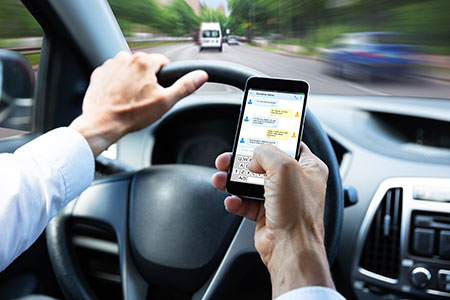Distracted Driving

Distracted driving has become one of the greatest dangers on our roadways. The National Highway Traffic Safety Administration (NHTSA), a part of the United States government, is working to raise awareness of this danger in an effort to make our roads safer. The following facts and statistics come from the NHTSA via distraction.gov.
What is distracted driving? Distracted driving is any activity that could divert a person’s attention away from the primary task of driving. All distractions endanger driver, passenger, and bystander safety. These types of distractions include:
- Texting
- Using a cell phone or
- smartphone
- Eating and drinking
- Talking to passengers
- Grooming
- Reading, including maps
- Using a navigation system
- Watching a video
- Adjusting a radio, CD player,
- or MP3 player
But, because text messaging requires visual, manual, and cognitive attention from the driver, it is by far the most alarming distraction. The best way to end distracted driving is to educate all Americans about the danger it poses. On this page, you’ll find facts and statistics that are powerfully persuasive. If you don’t already think distracted driving is a safety problem, please take a moment to learn more. And, as with everything on distraction.gov, please share these facts with others. Together, we can help save lives.
Key Facts and Statistics
In 2014, 3,179 people were killed, and 431,000 were injured in motor vehicle crashes involving distracted drivers.
- As of December 2014, 169.3 billion text messages were sent in the US (includes PR, the Territories, and Guam) every month.
- Ten percent of all drivers 15 to 19 years old involved in fatal crashes were reported as distracted at the time of the crashes. This age group has the largest proportion of drivers who were distracted at the time of the crashes.
- Drivers in their 20s are 23 percent of drivers in all fatal crashes, but are 27 percent of the distracted drivers and 38 percent of the distracted drivers who were using cell phones in fatal crashes.
- The percentage of drivers text-messaging or visibly manipulating handheld devices increased from 1.7 percent in 2013 to 2.2 percent in 2014. Since 2007, young drivers (age 16 to 24) have been observed manipulating electronic devices at higher rates than older drivers.
- At any given daylight moment across America, approximately 660,000 drivers are using cell phones or manipulating electronic devices while driving, a number that has held steady since 2010.
- A 2015 Erie Insurance distracted driving survey reported that drivers do all sorts of dangerous things behind the wheel including brushing teeth and changing clothes. The survey also found that onethird of drivers admitted to texting while driving, and three-quarters saying they’ve seen others do it.
- Five seconds is the average time your eyes are off the road while texting. When traveling at 55mph, that’s enough time to cover the length of a football field blindfolded. Smartphone ownership is growing. In 2011, 52 percent of drivers reported owning a smartphone, and by 2014 that number had grown to 80 percent. The greatest increases in smartphone ownership are among adults age 40 and older.
- More than half (53%) of all adult cellphone owners have been on the giving or receiving end of a distracted walking encounter.
